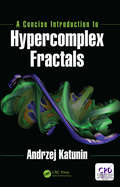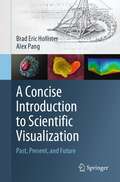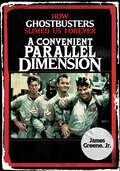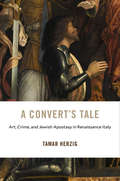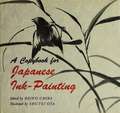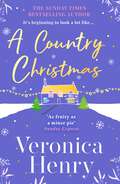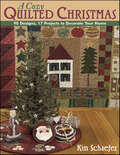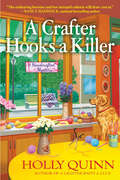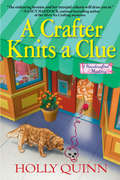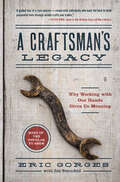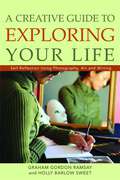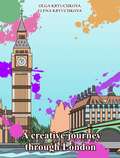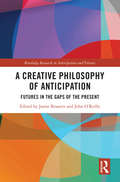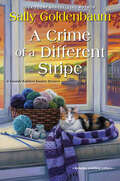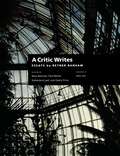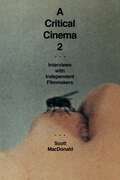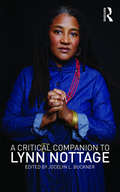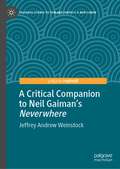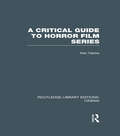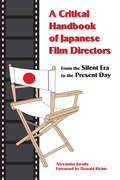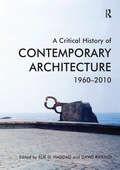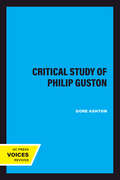- Table View
- List View
A Concise Introduction to Engineering Graphics Including Worksheet Series A
by Timothy SextonA Concise Introduction to Engineering Graphics is a focused book designed to give you a solid understanding of how to create and read engineering drawings. It consists of thirteen chapters that cover all the fundamentals of engineering graphics. Included with your purchase of A Concise Introduction to Engineering Graphics is a free digital copy of Technical Graphics and video lectures. This book is unique in its ability to help you quickly gain a strong foundation in engineering graphics, covering a breadth of related topics, while providing you with hands-on worksheets to practice the principles described in the book. The bonus digital copy of Technical Graphics is an exhaustive resource and allows you to further explore specific engineering graphics topics in greater detail.
A Concise Introduction to Hypercomplex Fractals
by Andrzej KatuninThis book presents concisely the full story on complex and hypercomplex fractals, starting from the very first steps in complex dynamics and resulting complex fractal sets, through the generalizations of Julia and Mandelbrot sets on a complex plane and the Holy Grail of the fractal geometry – a 3D Mandelbrot set, and ending with hypercomplex, multicomplex and multihypercomplex fractal sets which are still under consideration of scientists. I tried to write this book in a possibly simple way in order to make it understandable to most people whose math knowledge covers the fundamentals of complex numbers only. Moreover, the book is full of illustrations of generated fractals and stories concerned with great mathematicians, number spaces and related fractals. In the most cases only information required for proper understanding of a nature of a given vector space or a construction of a given fractal set is provided, nevertheless a more advanced reader may treat this book as a fundamental compendium on hypercomplex fractals with references to purely scientific issues like dynamics and stability of hypercomplex systems.
A Concise Introduction to Scientific Visualization: Past, Present, and Future
by Brad Eric Hollister Alex PangScientific visualization has always been an integral part of discovery, starting first with simplified drawings of the pre-Enlightenment and progressing to present day. Mathematical formalism often supersedes visual methods, but their use is at the core of the mental process. As historical examples, a spatial description of flow led to electromagnetic theory, and without visualization of crystals, structural chemistry would not exist. With the advent of computer graphics technology, visualization has become a driving force in modern computing. A Concise Introduction to Scientific Visualization – Past, Present, and Future serves as a primer to visualization without assuming prior knowledge. It discusses both the history of visualization in scientific endeavour, and how scientific visualization is currently shaping the progress of science as a multi-disciplinary domain.
A Connecticut Christmas: Celebrating the Holiday in Classic New England Style
by Caryn B. DavisCelebrate the Holiday Traditions of the Nutmeg State!A Connecticut Christmas is a photographic journey celebrating classic New England traditions, beauty, spirit, and community surrounding the holiday. From light displays to decorated churches and inns, spectacular private homes, festivals, carolers, town greens, and picturesque villages, this beautiful book of images and accompanying essays takes readers on a magical holiday tour through the Nutmeg State
A Convenient Parallel Dimension: How Ghostbusters Slimed Us Forever
by James Greene Jr.&“Rarely has a movie this expensive provided so many quotable lines.&” So wrote Roger Ebert in his review of Ghostbusters, the 1984 blockbuster that handed our paranormal fears over to some of the sharpest comic minds of the day. Ghostbusters instantly resonated with audiences thanks to eye-popping special effects and crackling wit; to date, it remains the highest-grossing horror comedy of all time. The film spawned an Emmy-nominated Saturday morning cartoon, a tentpole 1989 sequel, a contentious 2016 reboot, legions of merchandise, and one of the most dedicated fan bases in history. Ghostbusters also elevated its players to superstardom, something a few cast members found more daunting than the Stay Puft Marshmallow Man. Now, for the first time, the entire history of the slime-soaked franchise is told in A Convenient Parallel Dimension: How Ghostbusters Slimed Us Forever. The cohesion of talent during the mid-&’70s comedy revolution, the seat-of-their-pants creation of the first Ghostbusters, the explosive success that seemed to mandate a franchise, the five year struggle to make Ghostbusters II, the thirty-one-year struggle to make Ghostbusters III—it&’s all here, with incredible attention to detail. Thoroughly researched and engaging, A Convenient Parallel Dimension smashes long-held myths and half truths about the dynamics behind this cultural juggernaut and presents the real story, down to the last drop of ectoplasm.
A Convert’s Tale: Art, Crime, and Jewish Apostasy in Renaissance Italy (I Tatti Studies In Italian Renaissance History Ser. #23)
by Tamar HerzigSalomone da Sesso was a virtuoso goldsmith in Renaissance Italy. Brought down by a sex scandal, he saved his skin by converting to Catholicism. Tamar Herzig explores Salamone’s world—his Jewish upbringing, his craft and patrons, and homosexuality. In his struggle for rehabilitation, we see how precarious and contested was the meaning of conversion.
A Copybook for Japanese Ink - Painting
by Shutei Ota Reiko ChibaThis book is designed for the amateur artist who is eager to find a new outlet for his talents as well as for the one who has already discovered the enchantingworld of Japanese ink-painting. It is, quite frankly, a copybook, and it does not pretend to be anything else. As editor Reiko Chiba says of the paintings in the book, "These basic inspirations are to be individually altered and improved." The paintings are the work of Shutei Ota, an artist who has had a long career of introducing Japanese ink-painting to Westerners. As a teacher, she has found the language barrier to be no handicap. She teaches by showing) by example, and by holding the hands of her students-beginning immediately with strokes and foregoing preliminary sketches. "Paint now" is her philosophy. She likes to think of her paintings as written compositions. Each stroke is a sentence, and each sentence builds up to a complete message or picture. In this book, examples graded from easy to difficult are given. Westerners will no doubt make practical use of the art to create place cards, greeting cards, Christmas cards, and the like for personal use. Beyond this, of course, the study of Japanese ink painting will lead to better understanding of the discipline of Oriental arts in general.
A Country Christmas: The heartwarming and unputdownable festive romance to escape with this holiday season! (Honeycote Book 1) (Honeycote)
by Veronica HenryEscape to the country this Christmas in this delightful festive read from bestselling author Veronica Henry.'As fruity as a mince pie' SUNDAY EXPRESSChristmas is coming to Honeycote House and Lucy Liddiard is busy whipping up a feast of festive treats (all with an extra dash of brandy!) for her nearest and dearest.She knows this year's celebrations need to be extra special - their beloved Cotswolds brewery is struggling and Lucy is sure that the secret her husband Mickey is hiding isn't a diamond necklace in her stocking...As the scent of cinnamon fills the air and the glamorous guests start to arrive, Lucy suspects there might be a few more secrets waiting underneath the Christmas tree...It's certainly going to be a holiday to remember!Irresistibly good fun and bursting with heart, A Country Christmas is the first book in the Honeycote series, followed by A Country Life and A Country Wedding.** This book was originally published as 'Honeycote' **Your favourite authors love Veronica Henry!'A blissful escape' SARAH MORGAN'The most uplifting getaway' LUCY DIAMOND'Veronica Henry writes like a dream' JILL MANSELL'Irresistibly romantic. I adored it' PHILLIPA ASHLEY'A delicious, dreamy, joy of a book' LIBBY PAGE'The perfect weekend read' FANNY BLAKE
A Country Christmas: The heartwarming and unputdownable festive romance to escape with this holiday season! (Honeycote Book 1) (Honeycote)
by Veronica HenryEscape to the country this Christmas in this delightful festive read from bestselling author Veronica Henry.'As fruity as a mince pie' SUNDAY EXPRESSChristmas is coming to Honeycote House and Lucy Liddiard is busy whipping up a feast of festive treats (all with an extra dash of brandy!) for her nearest and dearest.She knows this year's celebrations need to be extra special - their beloved Cotswolds brewery is struggling and Lucy is sure that the secret her husband Mickey is hiding isn't a diamond necklace in her stocking...As the scent of cinnamon fills the air and the glamorous guests start to arrive, Lucy suspects there might be a few more secrets waiting underneath the Christmas tree...It's certainly going to be a holiday to remember!Irresistibly good fun and bursting with heart, A Country Christmas is the first book in the Honeycote series, followed by A Country Life and A Country Wedding.** This book was originally published as 'Honeycote' **Your favourite authors love Veronica Henry!'A blissful escape' SARAH MORGAN'The most uplifting getaway' LUCY DIAMOND'Veronica Henry writes like a dream' JILL MANSELL'Irresistibly romantic. I adored it' PHILLIPA ASHLEY'A delicious, dreamy, joy of a book' LIBBY PAGE'The perfect weekend read' FANNY BLAKE
A Cozy Quilted Christmas: 90 Designs, 17 Projects to Decorate Your Home
by Kim SchaeferDeck the halls with 17 delightful projects to decorate your home for Christmas.
A Crafter Hooks a Killer (A Handcrafted Mystery)
by Holly QuinnSure to delight fans of Betty Hechtman and Maggie Sefton, A Crafter Hooks a Killer is the second installment in Holly Quinn’s Handcrafted mysteries.Community Craft proprietor Sammy Kane suspects that a tantalizing thread links the deaths of her best friend and a bestselling author. But can she weave together the clues?Samantha "Sammy" Kane is settling into her new life in idyllic Heartsford, Wisconsin, running her late friend Kate Allen’s craft shop, Community Craft when one early June day, bestselling crochet author Jane Johnson visits Heartsford. Captivated by Community Craft, Jane devotes a chapter in her new book, Behind the Seams, to the store. Sammy is honored, though satisfaction quickly turns to shock when she finds Jane strangled to death—her cold hands clutching a copy of her most recently published book, with the words "THE END" raggedly scratched into the cover.Heavens to Etsy! Not only must Sammy contend with the author’s inauspicious demise, she has to untie some knotty details from her own past. It turns out Kate’s death was not what it seemed, and instead somehow hooked to Jane Johnson’s demise. Handsome Detective Liam Nash is on the "skein", more than happy to see the shop owner again, if less than enamored by her sleuthing interventions. But this was Sammy’s best friend—she has to know.Fortunately, Sammy has a "lace" in the hole. As a child, she formed the S.H.E. detective team with her cousin, Heidi, and her sister, Ellie. Having already reconstituted their partnership, the S.H.E. team searches for a pattern behind the latest death. As the case starts to unravel, will Sammy and team be able to sidestep Liam quick enough to stitch together the clues?
A Crafter Knits a Clue (A Handcrafted Mystery #1)
by Holly QuinnFor fans of Betty Hechtman and Maggie Sefton, the latest craft frenzy is Holly Quinn’s Handcrafted series debut. Sammy Kane just moved back to her hometown to run a craft store. But when the owner of a nearby yarn shop is murdered, Sammy will needle little help finding the killer.When a heartbroken Samantha “Sammy” Kane returns to her hometown of Heartsford, WI, for her best friend Kate’s funeral, she learns that Kate’s much-loved craft store is in danger of perishing with its owner. Confounding all her expectations of the life she would live, Sammy moves back home with her golden retriever and takes over Community Craft. A few doors down Main Street, fellow new arrival Ingrid Wilson has just opened the Yarn Barn, a real “purl” of a shop. But when Sammy strolls over to see if Ingrid could use a little help, she finds Ingrid’s dead body—with a green aluminum knitting needle lodged in her throat. Detective Liam Nash is thrown for a loop as every single citizen of Heartsford seems to have a theory about Ingrid’s murder. And nearly everyone in town seems to be a suspect. But the last time Sammy did any sleuthing was as a little moppet. And this is not fun and games. Sammy is eager to help the handsome Liam—who seems to be endlessly inventive in finding reasons to talk with her—and when Liam arrests affable woodworker Miles Danbury, Sammy puts everything on the line to help clear Miles. As the case comes dangerously close to unraveling, Sammy must stitch the clues together. But the killer has other plans—and if Sammy’s not careful, she may wind up in a perilous knot in A Crafter Knits a Clue, the first warm and woolly yarn of Holly Quinn’s new Handcrafted mysteries.
A Craftsman's Legacy: Why Working with Our Hands Gives Us Meaning
by Jon Sternfeld Eric GorgesA book for makers, for seekers of all kinds, an exhilarating look into the heart and soul of artisans—and how their collective wisdom can inspire us all. "Despite our technological advances, we’re busier than ever, our lives more frazzled. That’s why the handmade object, created with care and detail, embodying a history and a tradition, is enormously powerful. It can cut through so much and speak in ways that we don’t often hear, or that we’ve forgotten." —Eric Gorges, from A Craftsman’s Legacy In this joyful celebration of skilled craftsmen, Eric Gorges, a corporate-refugee-turned-metal-shaper, taps into a growing hunger to get back to what’s real. Through visits with fellow artisans--calligraphers, potters, stone carvers, glassblowers, engravers, woodworkers, and more--many of whom he’s profiled for his popular television program, Gorges identifies values that are useful for all of us: taking time to slow down and enjoy the process, embracing failure, knowing when to stop and when to push through, and accepting that perfection is an illusion. Most of all, A Craftsman’s Legacy shows how all of us can embrace a more creative and authentic life and learn to focus on doing what we love.
A Creative Guide to Exploring Your Life: Self-Reflection Using Photography, Art, and Writing
by Graham Ramsay Holly SweetAn award-winning psychologist and professional photographer join forces in writing this unique creative guide to exploring and understanding your life: who you are, what you value, and what you wish to achieve. A Creative Guide to Exploring Your Life brims with imaginative exercises and examples that use the power of photography, art, and writing as tools for self-discovery. It provides clear and accessible guidance on how to explore different parts of your identity: take a photograph of yourself in a role you don't typically play, draw a visual timeline of your life and consider its key turning points; explore your sense of place in history by writing about a major historical event that has changed your life. Exercises are accompanied by searching questions for self-reflection, and are complemented by examples of each exercise to provoke ideas and inspiration. Featuring additional guidance for teachers, counselors, and other professionals running the exercises in group settings, this book offers a dynamic and enjoyable way for you to explore different aspects of your life.
A Creative Journey through London
by Olga Kryuchkova Elena KryuchkovaThis creative art book is devoted to views of the wonderful English city called London. Here you will find a stylized image with a short description, and a black and white copy of it. If you wish, you can take a screenshot of the black and white image and colour it in on a computer, or print it out and colour in the paper copy. When colouring in, you can use a coloured sample for guidance, or make your own decisions about the colours. Later, you can enjoy looking at the photos of the real views of London included in this book on the internet. The book gives you a chance to be creative, have a virtual tour of London and learn new facts about it. This art book has no age limits. The authors wish you success in your creative undertaking and lots of enjoyment! This colouring book can be used a means for anti-stress or art therapy. All images in this book have been created on the basis of photographs sourced from internet.
A Creative Philosophy of Anticipation: Futures in the Gaps of the Present (Routledge Research in Anticipation and Futures)
by Jamie Brassett and John O’ReillyThis edited collection highlights the valuable ontological and creative insights gathered from anticipation studies, which orients itself to the future in order to recreate the present. The gathered essays engage with many writers from speculative metaphysics to poetic philosophy, ancient writing systems to the fringes of pataphysics. The book situates itself as a creative intervention in and with various thinkers, designers, artists, scientists and poets to offer insight into ways of anticipating. It brings together philosophical practices for which creativity is both a fundamental area of consideration and a mode of working, a characterization of recent Continental Philosophy which takes a departure from traditional futures studies thinking. This book will be of interest to scholars and research in futures studies, anticipation, philosophy, creative practice and theories about creative practice, as well as the intersections between philosophy, creativity and business.
A Crime of a Different Stripe (Seaside Knitters Society #4)
by Sally GoldenbaumAs sleepy Sea Harbor, Massachusetts settles into the glow of autumn, a baby-on-the-way has the Seaside Knitters feeling warm and fuzzy. Only, these crafty ladies can&’t get too cozy when sweater weather delivers an unexpected arrival—murder! While nonchalant mother-to-be Cass Halloran tries downplaying her pregnancy, a softer side of the no-nonsense lobsterwoman emerges as the Seaside Knitters create heaps of delicate hats and booties for her bundle of joy. But in contrast to the happy news, terrifying events unfold at the town&’s art series that puts a real chill in their New England fall . . . Izzy Perry&’s husband Sam had reservations about inviting his one-time mentor Harrison Grant to speak at the opening reception, although he never imagined the famed and charismatic photographer would rudely embarrass his hosts that evening. But when a dead body turns up along the wooded shoreline the next day, startling secrets come into focus that could undo the tight-knit community of local artists . . . With a mysterious murder pitting neighbors against each other, Izzy, Birdie, Nell, and a vulnerable Cass find themselves entangled in a dangerous hunt for answers. Can four best friends somehow tie together scattered clues and pacify a list of potential culprits before a cascade of fallen foliage buries the pièce de résistanceof a ruthless killer?Praise for the Seaside Knitters Mysteries &“Add a cup of tea, a roaring fire, and you&’ve got the perfect cozy evening.&” —New York Times bestselling author Rhys Bowen &“Goldenbaum&’s plotting is superb, her characters are richly drawn . . . and her prose is seamless.&”—Richmond Times Dispatch
A Critic Writes: Selected Essays by Reyner Banham
by Reyner BanhamFew twentieth-century writers on architecture and design have enjoyed the renown of Reyner Banham. Born and trained in England and a U.S. resident starting in 1976, Banham wrote incisively about American and European buildings and culture. Now readers can enjoy a chronological cross-section of essays, polemics, and reviews drawn from more than three decades of Banham's writings.The volume, which includes discussions of Italian Futurism, Adolf Loos, Paul Scheerbart, and the Bauhaus as well as explorations of contemporary architecture by Frank Gehry, James Stirling, and Norman Foster, conveys the full range of Banham's belief in industrial and technological development as the motor of architectural evolution. Banham's interests and passions ranged from architecture and the culture of pop art to urban and industrial design. In brilliant analyses of automobile styling, mobile homes, science fiction films, and the American predilection for gadgets, he anticipated many of the preoccupations of contemporary cultural studies. Los Angeles, the city that Banham commemorated in a book and a film, receives extensive attention in essays on the Santa Monica Pier, the Getty Museum, Forest Lawn cemetery, and the ubiquitous freeway system.Eminently readable, provocative, and entertaining, this book is certain to consolidate Banham's reputation among architects and students of contemporary culture. For those acquainted with his writing, it offers welcome surprises as well as familiar delights. For those encountering Banham for the first time, it comprises the perfect introduction.
A Critical Cinema 2: Interviews with Independent Filmmakers
by Scott MacDonaldThis sequel to A Critical Cinema offers a new collection of interviews with independent filmmakers that is a feast for film fans and film historians. Scott MacDonald reveals the sophisticated thinking of these artists regarding film, politics, and contemporary gender issues.The interviews explore the careers of Robert Breer, Trinh T. Minh-ha, James Benning, Su Friedrich, and Godfrey Reggio. Yoko Ono discusses her cinematic collaboration with John Lennon, Michael Snow talks about his music and films, Anne Robertson describes her cinematic diaries, Jonas Mekas and Bruce Baillie recall the New York and California avant-garde film culture. The selection has a particularly strong group of women filmmakers, including Yvonne Rainer, Laura Mulvey, and Lizzie Borden. Other notable artists are Anthony McCall, Andrew Noren, Ross McElwee, Anne Severson, and Peter Watkins.
A Critical Companion to Lynn Nottage
by Jocelyn L. BucknerA Critical Companion to Lynn Nottage places this renowned, award-winning playwright's contribution to American theatre in scholarly context. The volume covers Nottage's plays, productions, activism, and artistic collaborations to display the extraordinary breadth and depth of her work. The collection contains chapters on each of her major works, and includes a special three-chapter section devoted to Ruined, winner of the 2009 Pulitzer Prize. The anthology also features an interview about collaboration and creativity with Lynn Nottage and two of her most frequent directors, Seret Scott and Kate Whoriskey.
A Critical Companion to Neil Gaiman's "Neverwhere" (Palgrave Science Fiction and Fantasy: A New Canon)
by Jeffrey Andrew WeinstockFantasy author Neil Gaiman’s 1996 novel Neverwhere is not just a marvelous self-contained novel, but a terrifically useful text for introducing students to fantasy as a genre and issues of adaptation. Jeffrey Andrew Weinstock’s briskly written A Critical Companion to Neil Gaiman’s Neverwhere offers an introduction to the work; situates it in relation to the fantasy genre, with attention in particular to the Hero’s Journey, urban fantasy, word play, social critique, and contemporary fantasy trends; and explores it as a case study in transmedial adaptation. The study ends with an interview with Neil Gaiman that addresses the novel and a bibliography of scholarly works on Gaiman.
A Critical Guide to Horror Film Series (Routledge Library Editions: Cinema)
by Ken HankeIn this book the author takes a fresh look at horror film series as series and presents an understanding of how the genre thrived in this format for a large portion of its history. It sheds light on older films such as the Universal and the Hammer series films on Dracula, Frankenstein and the Mummy as well as putting more recent series into perspective, such as The Nightmare on Elm Street films. A well rounded review of these films and investigation into their success as a format, this useful volume, originally published in 1991, offers an attempt to understand the marriage of horror and the series film, with its pluses as well as minuses.
A Critical Handbook of Japanese Film Directors
by Donald Richie Alexander JacobyThis important work fills the need for a reasonably priced yet comprehensive volume on major directors in the history of Japanese film. With clear insight and without academic jargon, Jacoby examines the works of over 150 filmmakers to uncover what makes their films worth watching.Included are artistic profiles of everyone from Yutaka Abe to Isao Yukisada, including masters like Kinji Fukasaku, Juzo Itami, Akira Kurosawa, Takashi Miike, Kenji Mizoguchi, Yasujiro Ozu, and Yoji Yamada. Each entry includes a critical summary and filmography, making this book an essential reference and guide.UK-based Alexander Jacoby is a writer and researcher on Japanese film.
A Critical History of Contemporary Architecture: 1960-2010
by Elie G. Haddad David Rifkind1960, following as it did the last CIAM meeting, signalled a turning point for the Modern Movement. From then on, architecture was influenced by seminal texts by Aldo Rossi and Robert Venturi, and gave rise to the first revisionary movement following Modernism. Bringing together leading experts in the field, this book provides a comprehensive, critical overview of the developments in architecture from 1960 to 2010. It consists of two parts: the first section providing a presentation of major movements in architecture after 1960, and the second, a geographic survey that covers a wide range of territories around the world. This book not only reflects the different perspectives of its various authors, but also charts a middle course between the 'aesthetic' histories that examine architecture solely in terms of its formal aspects, and the more 'ideological' histories that subject it to a critique that often skirts the discussion of its formal aspects.
A Critical Study of Philip Guston
by Dore AshtonThis title is part of UC Press's Voices Revived program, which commemorates University of California Press’s mission to seek out and cultivate the brightest minds and give them voice, reach, and impact. Drawing on a backlist dating to 1893, Voices Revived makes high-quality, peer-reviewed scholarship accessible once again using print-on-demand technology. This title was originally published in 1976.This title is part of UC Press's Voices Revived program, which commemorates University of California Press’s mission to seek out and cultivate the brightest minds and give them voice, reach, and impact. Drawing on a backlist dating to 1893, Voices Revived</DIV

